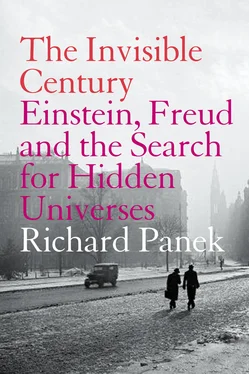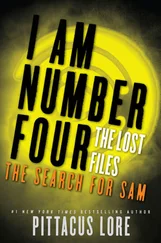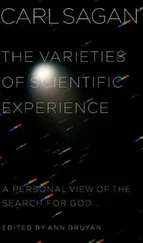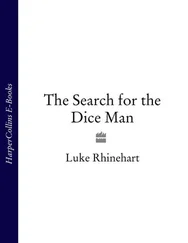For instance, absolute space, the existence of which is necessary to measure absolute motions: On close reading, Newton’s definition of it turned out to be every bit as circular as the reigning definition of the ether. “Absolute motion,” Newton had written, “is the translation of a body from one absolute place into another.” And what is place? “Place is a part of space which a body takes up, and is according to the space, either absolute or relative.” So what, then, is absolute space? “Absolute space, in its own nature, without relation to anything external, remains always similar and immovable.” Newton anticipated some criticism: “It is indeed a matter of great difficulty to discover, and effectually to distinguish, the true motions of particular bodies from the apparent; because the parts of that immovable space, in which those motions are performed, do by no means come under the observation of our senses. Yet the thing is not altogether desperate,” he reassured the reader, “for we have some arguments to guide us, partly from the apparent motions, which are the differences of the true motions; partly from the forces, which are the causes and effects of the true motions.” And what are these true, or absolute, motions? See above.
“We join with the eminent physicist Thomson [later Lord Kelvin] in our reverence and admiration of Newton,” Mach wrote in 1883. “But we can only comprehend with difficulty his opinion that the Newtonian doctrines still remain the best and most philosophical foundation that can be given.” Not that Mach was proposing an alternative to Newtonian mechanics; not that he was even suggesting physics was in need of an alternative. Rather, he was trying to remind his fellow physicists that just because mechanics had come “historically first” in modern science didn’t mean that it had to be historically final . This was the argument that “shook” Einstein’s “dogmatic faith” in mechanics alone as the basis of the physical world, and now, in May 1905, this was the argument that led Einstein to wonder whether mechanics and electromagnetism together could accommodate a principle of relativity—whether a synthesis of those two systems might in fact be historically next .
He tried it. First Einstein proposed that just as Newton’s mechanics don’t allow observers either on a dock or on a ship to consider themselves to be the ones absolutely at rest, neither should electrodynamics and optics. “We shall raise this conjecture (whose content will hereafter be called ‘the principle of relativity’) to the status of a postulate,” he wrote in the second paragraph of his paper. Then he accepted the constancy of the speed of light in empty space as another given—a second postulate: that the speed of light in a vacuum is always the same “independent of the state of motion of the emitting body.”
And that was all. It worked. Einstein now had two mutually reinforcing postulates, “only apparently irreconcilable”: a principle of relativity, allowing us to conduct experiments involving light either on the ship or on the dock with equal validity; and a principle of constancy, allowing the ship (or the dock, for that matter) to approach the speed of light without any light onboard (or on the dock)—including electromagnetic waves bringing images from objects to our eyes—slowing to a stop and thereby revealing whether the ship (or dock) is the one “really” in motion. In which case, as Einstein promised his readers in that same second paragraph, the “introduction of a ‘light ether’ will prove to be superfluous, inasmuch as the view to be developed here will not require a ‘space at absolute rest’ endowed with special properties.”
The rest was math—high-school-level algebra, at that. Suppose that you’re standing on a dock watching our old Galilean ship, still anchored just offshore after all these centuries. And suppose that the ship is absolutely motionless in the water. And suppose that instead of dropping a stone, someone on board is dropping a light signal—sending a beam of light from the top of the mast to the deck. If you time this simple event and get an answer of, say, one second, then you know that the distance between the top of the mast and the deck must be the distance that light travels in one second, or 186,282 miles. (It’s a big ship.)
The complications begin, just as they did in Galileo’s day, once that ship lifts anchor and sets sail. Suppose that it’s moving at a constant speed across your line of sight. If the person at the top of the mast sends a second light signal in the same manner as the first, what will you see from your vantage on the dock? The Aristotelian answer: a streak of light heading straight for the center of the Earth and therefore landing some distance behind the base of the mast—a distance corresponding to how far the ship has traveled along the water during the signal’s journey. The Galilean answer: a streak of light heading straight for the base of the mast—which is the Einsteinian answer as well. From your point of view, the base of the mast will have moved out from under the top of the mast during the descent of the beam of light, just as it did during the descent of a stone. Which means the distance the light has traveled, from your point of view, has lengthened. It’s not 186,282 miles. It’s more.
How much more you can easily find out by measuring the time of its journey—and that’s where the Einsteinian interpretation begins to depart from the Galilean. What is velocity? Nothing but distance divided by time, whether inches divided by—or, in the vernacular, per —day or kilometers per hour or miles per second. But if we accept Einstein’s second postulate, then the velocity in question isn’t just 186,282 miles per second. It’s always 186,282 miles per second. It’s constant—indeed, a constant . In the equation “velocity equals distance divided by time,” this constant is over on one side of the equals sign, off by itself, humming along at its own imperturbable rate. On the opposite side of the equals sign are the parts of the equation that can vary, that are indeed the variables —distance and time, also known as miles and seconds. They can undergo as many permutations as you can imagine, as long as they continue to divide in such a way that the result is 186,282 miles per second, or the equivalent—372,564 miles per two seconds, or 558,846 miles per three seconds, or 1,862,820 per ten seconds, and so on. Change the distance, and you have to change the time.
You have to change the time .
For more than two centuries, though, you didn’t. Now, on an evening in May 1905, you suddenly did, because on that evening Einstein, having talked the problem through with his friend Besso, realized that he needed to take into account something he’d never before adequately considered: the “inseparable connection between time and the signal velocity.” Time was a variable, a measurement that passed at different rates according to where you were. To an observer on the dock, the second light signal would had to have lasted longer than one second. To an observer on the ship, however, the second light signal would have appeared to do what the first one had done, back when the ship was anchored in the water: travel straight down to the base of the mast, 186,282 miles away. For this observer, the distance wouldn’t have differed from one signal to the next, so the time wouldn’t have, either. The shipboard observer would be measuring one second while you on the dock would have been counting two seconds or three seconds or more, depending on the speed of the ship along the water. For this reason, you would have every right to say that clocks on board the ship were moving slowly. And there it is: a new principle of relativity.
Читать дальше











